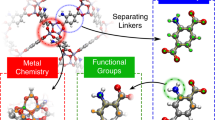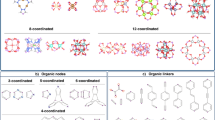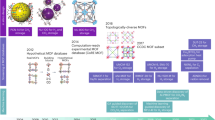Abstract
Metal–organic frameworks (MOFs) are porous materials constructed from modular molecular building blocks, typically metal clusters and organic linkers. These can, in principle, be assembled to form an almost unlimited number of MOFs, yet materials reported to date represent only a tiny fraction of the possible combinations. Here, we demonstrate a computational approach to generate all conceivable MOFs from a given chemical library of building blocks (based on the structures of known MOFs) and rapidly screen them to find the best candidates for a specific application. From a library of 102 building blocks we generated 137,953 hypothetical MOFs and for each one calculated the pore-size distribution, surface area and methane-storage capacity. We identified over 300 MOFs with a predicted methane-storage capacity better than that of any known material, and this approach also revealed structure–property relationships. Methyl-functionalized MOFs were frequently top performers, so we selected one such promising MOF and experimentally confirmed its predicted capacity.
This is a preview of subscription content, access via your institution
Access options
Subscribe to this journal
Receive 12 print issues and online access
$259.00 per year
only $21.58 per issue
Buy this article
- Purchase on Springer Link
- Instant access to full article PDF
Prices may be subject to local taxes which are calculated during checkout






Similar content being viewed by others
References
Rosi, N. L. et al. Hydrogen storage in microporous metal–organic frameworks. Science 300, 1127–1129 (2003).
Wang, B., Côté, A. P., Furukawa, H., O'Keeffe, M. & Yaghi, O. M. Colossal cages in zeolitic imidazolate frameworks as selective carbon dioxide reservoirs. Nature 453, 207–211 (2008).
Ferey, G. Physical chemistry: trapped gas. Nature 436, 187–188 (2005).
Matsuda, R. et al. Highly controlled acetylene accommodation in a metal–organic microporous material. Nature 436, 238–241 (2005).
Düren, T., Sarkisov, L., Yaghi, O. M. & Snurr, R. Q. Design of new materials for methane storage. Langmuir 20, 2683–2689 (2004).
Murray, L., Dinca, M. & Long, J. Hydrogen storage in metal–organic frameworks. Chem. Soc. Rev. 38, 1294–1314 (2009).
Seo, J. et al. A homochiral metal–organic porous material for enantioselective separation and catalysis. Nature 404, 982–986 (2000).
Bradshaw, D., Prior, T. J., Cussen, E. J., Claridge, J. B. & Rosseinsky, M. J. Permanent microporosity and enantioselective sorption in a chiral open framework. J. Am. Chem. Soc. 126, 6106–6114 (2004).
Düren, T. & Snurr, R. Q. Assessment of isoreticular metal–organic frameworks for adsorption separations: a molecular simulation study of methane/n-butane mixtures. J. Phys. Chem. B 108, 15703–15708 (2004).
Watanabe, T., Keskin, S., Nair, S. & Sholl, D. S. Computational identification of a metal organic framework for high selectivity membrane-based CO2/CH4 separations: Cu(hfipbb)(H2hfipbb)0.5 . Phys. Chem. Chem. Phys. 11, 11389–11394 (2009).
Liu, B. et al. Enhanced adsorption selectivity of hydrogen/methane mixtures in metal–organic frameworks with interpenetration: a molecular simulation study. J. Phys. Chem. C 112, 9854–9860 (2008).
Li, J-R., Kuppler, R. J. & Zhou, H-C. Selective gas adsorption and separation in metal–organic frameworks. Chem. Soc. Rev. 38, 1477–1504 (2009).
Corma, A. From microporous to mesoporous molecular sieve materials and their use in catalysis. Chem. Rev. 97, 2373–2419 (1997).
Lee, J. et al. Metal–organic framework materials as catalysts. Chem. Soc. Rev. 38, 1450–1459 (2009).
Lan, A. et al. A luminescent microporous metal–organic framework for the fast and reversible detection of high explosives. Angew. Chem. Int. Ed. 48, 2334–2338 (2009).
Franke, M. E. et al. Development and working principle of an ammonia gas sensor based on a refined model for solvate supported proton transport in zeolites. Phys. Chem. Chem. Phys. 5, 5195–5198 (2003).
Allendorf, M. D. et al. Stress-induced chemical detection using flexible metal–organic frameworks. J. Am. Chem. Soc. 130, 14404–14405 (2008).
Kokotailo, G. T., Lawton, S. L., Olson, D. H. & Meier, W. M. Structure of synthetic zeolite ZSM-5. Nature 272, 437–438 (1978).
Kitagawa, S., Kitaura, R. & Noro, S-I. Functional porous coordination polymers. Angew. Chem. Int. Ed. 43, 2334–2375 (2004).
Li, H., Eddaoudi, M., O'Keeffe, M. & Yaghi, O. Design and synthesis of an exceptionally stable and highly porous metal–organic framework. Nature 402, 276–279 (1999).
Ferey, G. Hybrid porous solids: past, present, future. Chem. Soc. Rev. 37, 191–214 (2008).
Furukawa, H. et al. Ultrahigh porosity in metal–organic frameworks. Science 329, 424–428 (2010).
Ferey, G. et al. A chromium terephthalate-based solid with unusually large pore volumes and surface area. Science 309, 2040–2042 (2005).
Chae, H. K. et al. A route to high surface area, porosity and inclusion of large molecules in crystals. Nature 427, 523–527 (2004).
Farha, O. K. et al. De novo synthesis of a metal–organic framework material featuring ultrahigh surface area and gas storage capacities. Nature Chem. 2, 944–948 (2010).
Zaworotko, M. J. Materials science: designer pores made easy. Nature 451, 410–411 (2008).
Moulton, B. & Zaworotko, M. J. From molecules to crystal engineering: supramolecular isomerism and polymorphism in network solids. Chem. Rev. 101, 1629–1658 (2001).
Ockwig, N. W., Delgado-Friedrichs, O., O'Keeffe, M. & Yaghi, O. M. Reticular chemistry: occurrence and taxonomy of nets and grammar for the design of frameworks. Acc. Chem. Res. 38, 176–182 (2005).
Yaghi, O. M. et al. Reticular synthesis and the design of new materials. Nature 423, 705–714 (2003).
Eddaoudi, M. et al. Systematic design of pore size and functionality in isoreticular MOFs and their application in methane storage. Science 295, 469–472 (2002).
Eddaoudi, M. et al. Modular chemistry: secondary building units as a basis for the design of highly porous and robust metal–organic carboxylate frameworks. Acc. Chem. Res. 34, 319–330 (2001).
Perry, J. J. IV & Perman, J. A. Design and synthesis of metal–organic frameworks using metal–organic polyhedra as supermolecular building blocks. Chem. Soc. Rev. 38, 1400–1417 (2009).
Vaidhyanathan, R. et al. Direct observation and quantification of CO2 binding within an amine-functionalized nanoporous solid. Science 330, 650–653 (2010).
Frost, H., Düren, T. & Snurr, R. Q. Effects of surface area, free volume, and heat of adsorption on hydrogen uptake in metal–organic frameworks. J. Phys. Chem. B 110, 9565–9570 (2006).
Earl, D. J. & Deem, M. W. Toward a database of hypothetical zeolite structures. Ind. Eng. Chem. Res. 45, 5449–5454 (2006).
Haldoupis, E., Nair, S. & Sholl, D. S. Pore size analysis of >250,000 hypothetical zeolites. Phys. Chem. Chem. Phys. 13, 5053–5060 (2011).
Baerlocher, Ch. & McCusker, L. B. Database of zeolite structures: http://www.iza-structure.org/databases/.
Haldoupis, E., Nair, S. & Sholl, D. S. Efficient calculation of diffusion limitations in metal organic framework materials: a tool for identifying materials for kinetic separations. J. Am. Chem. Soc. 7258–7539 (2010).
Lin, X. et al. High capacity hydrogen adsorption in Cu(II) tetracarboxylate framework materials: the role of pore size, ligand functionalization, and exposed metal sites. J. Am. Chem. Soc. 131, 2159–2171 (2009).
Ma, S. et al. Metal–organic framework from an anthracene derivative containing nanoscopic cages exhibiting high methane uptake. J. Am. Chem. Soc. 130, 1012–1016 (2008).
Chui, S. S-Y., Lo, S. M-F., Charman, J. P. H., Orpen, A. G. & Williams, I. D. A chemically functionalizable nanoporous material [Cu3(TMA)2(H2O)3]n . Science 283, 1148–1150 (1999).
Barthelet, K., Marrot, J., Riou, D. & Férey, G. A breathing hybrid organic–inorganic solid with very large pores and high magnetic characteristics. Angew. Chem. Int. Ed. 41, 281–284 (2002).
Rappé, A. K., Casewit, C. J., Colwell, K. S., Goddard, W. A. III & Skiff, W. M. UFF, a full periodic table force field for molecular mechanics and molecular dynamics simulations. J. Am. Chem. Soc. 114, 10024–10035 (1992).
Materials Studio v 5.0. Accelrys Software Inc., San Diego, California 92121, USA.
Düren, T., Bae, Y.-S. & Snurr, R. Q. Using molecular simulation to characterise metal–organic frameworks for adsorption applications. Chem. Soc. Rev. 38, 1237–1247 (2009).
Menon, V. C. & Komarneni, S. Porous adsorbents for vehicular natural gas storage: a review. J. Porous Mater. 5, 43–58 (1998).
Zhou, W. Methane storage in porous metal–organic frameworks: current records and future perspectives. Chem. Rec. 10, 200–204 (2010).
Senkovska, I. & Kaskel, S. High pressure methane adsorption in the metal–organic frameworks Cu3(btc)2, Zn2(bdc)2dabco, and Cr3F(H2O)2O(bdc)3 . Micropor. Mesopor. Mat. 112, 108–115 (2008).
Deng, H. et al. Multiple functional groups of varying ratios in metal–organic frameworks. Science 327, 846–850 (2010).
Wu, H. et al. Metal–organic frameworks with exceptionally high methane uptake: where and how is methane stored? Chem. Eur. J. 16, 5205–5214 (2010).
Walton, K. S. & Snurr, R. Q. Applicability of the BET method for determining surface areas of microporous metal–organic frameworks. J. Am. Chem. Soc. 129, 8552–8556 (2007).
Xu, Q. & Zhong, C. A general approach for estimating framework charges in metal–organic frameworks. J. Phys. Chem. C 114, 5035–5042 (2010).
Wilmer, C. E. & Snurr, R. Q. Towards rapid computational screening of metal–organic frameworks for carbon dioxide capture: calculation of framework charges via charge equilibration. Chem. Eng. J. 171, 775–781 (2011).
Acknowledgements
The authors thank Y. Aktan and M. Tsao for the supporting calculations, as well as M.A. Wilmer for significant contributions to the website interface to the hypothetical MOF database. R.Q.S. acknowledges support by the Defense Threat Reduction Agency (grant HDTRA1-09-1-0007). Computational work was supported through the resources provided by Information Technology at Northwestern University as part of its shared cluster program, Quest. J.T.H. and O.K.F. acknowledge support from the US Deptartment of Energy, Office of Science, Basic Energy Sciences program (grant DE-FG02-08ER15967) and the Northwestern Nanoscale Science and Engineering Center. C.E.W. acknowledges support from a Fellowship from the Initiative for Sustainability and Energy at Northwestern and a Ryan Fellowship from the Northwestern University International Institute for Nanotechnology.
Author information
Authors and Affiliations
Contributions
C.E.W. designed the research, implemented the algorithms and performed the simulations with assistance from M.L. and guidance from R.Q.S. O.K.F helped in ligand and node selection. The NOTT-107 ligand was synthesized by O.K.F. and C.Y.L. NOTT-107 was synthesized and activated by O.K.F. NOTT-107 physical characterization was done by B.G.H. Experimental data interpretation and MOF-activation methodology was developed by J.T.H. and O.K.F. All authors discussed the results, contributed to writing the manuscript and commented on it.
Corresponding author
Ethics declarations
Competing interests
The authors declare no competing financial interests.
Supplementary information
Supplementary information
Supplementary information (PDF 2451 kb)
Rights and permissions
About this article
Cite this article
Wilmer, C., Leaf, M., Lee, C. et al. Large-scale screening of hypothetical metal–organic frameworks. Nature Chem 4, 83–89 (2012). https://doi.org/10.1038/nchem.1192
Received:
Accepted:
Published:
Issue Date:
DOI: https://doi.org/10.1038/nchem.1192
This article is cited by
-
Progress toward the computational discovery of new metal–organic framework adsorbents for energy applications
Nature Energy (2024)
-
Gas adsorption meets deep learning: voxelizing the potential energy surface of metal-organic frameworks
Scientific Reports (2024)
-
Diffusion-rate sieving of propylene and propane mixtures in a cooperatively dynamic porous crystal
Nature Communications (2024)
-
Switching molecular recognition selectivities by temperature in a diffusion-regulatory porous material
Nature Communications (2024)
-
Prediction of specific surface area of metal–organic frameworks by graph kernels
The Journal of Supercomputing (2024)



